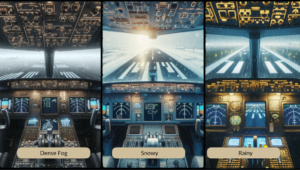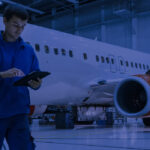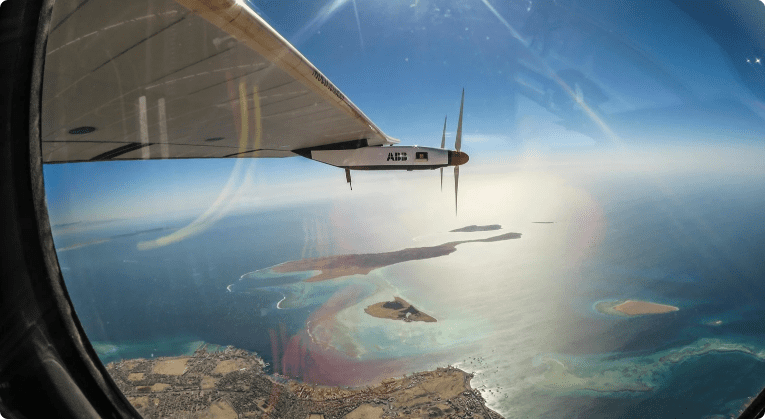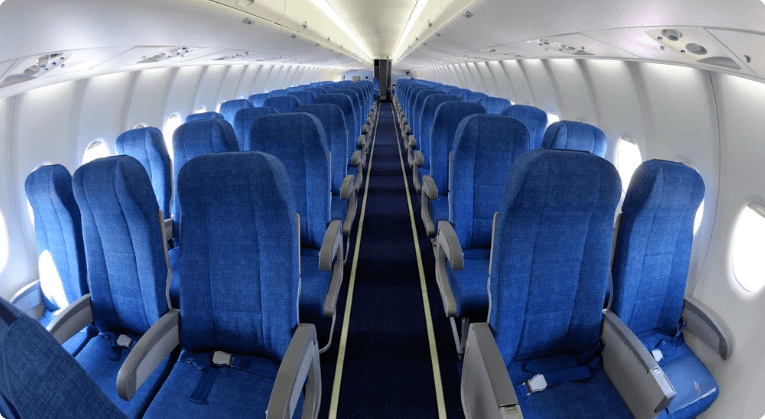Think this: you are now in a virtual cockpit, where you see the perfect details of every gauge and switch—everything within your reach. Not only that, but you can hear the roar of the engine and be mesmerised by the realistic cityscape! Wow, isn’t it?
VR technology has fast evolved and is the new modus operandi that is used in the training of pilots, cabin crews, and ground personnel. Airlines like Lufthansa are already reaping the benefits, with the participation of more than 20,000 flight attendants having completed VR training sessions. However, regardless of the estimated growth of the aircraft simulation market (to nearly $9 billion by 2028), VR adoption in aviation is not without its challenges.
Virtual reality isn’t just for games anymore; it can now be used to train our future pilots and hon their skills in every scenario similar to the real world. Aviation training is just up to par!
Transforming Aviation Education: VR’s Role in Pilot Skill Development
The aviation industry is all about safety—always! Though the traditional training methods may be valuable, they are limited. On the other hand, VR technology is not just allowing pilots to train in different scenarios, but overall, it is transforming the landscape as it can allow more and more pilots to be trained in one place without utilising aviation fuel. Here’s what’s new in VR aviation training:
- Hyper-Realistic Environments: Remember the old games where the graphics were poor? Well, with VR, we have realistic graphics, so pilots can be trained in any environment, whether it is rainy, dense fog, or snowy weather, on a runway, in the sky about to land, and more. These graphics are stunning and detailed to help the pilots sharpen their skills without being in the aircraft. Hence, you can practice take-offs and landings easily.
- Interactive Training Modules: VR training embraces the principles of learning in a controlled environment, which can be altered based on the requirements. We, in the aviation industry, have various interactive modules that allow pilots and other technical teams to practice procedures, troubleshoot problems, and more that are similar in the real world. Hence, as a learner, you can make mistakes and learn from them without real-world consequences.
- Tailored Training Programs: One-size-fits-all doesn’t work when it comes to aviation training. Hence, the VR programmes are customisable for student pilots, captains, first officers, and more based on aircraft types such as private planes, commercial planes, helicopters, and more. These are also tailored to various operational situations, ensuring pilots are prepared for a wide range of situations they will encounter in real life.

Benefits of VR Training
VR training offers numerous advantages for pilots, and other aviation-related professionals.
- Cost-Effectiveness: VR training isn’t just about the VR headset; we need physical simulators. Hence, we don’t have to rent out the planes or construct mock-ups. VR is expensive, yet cost-effective, in comparison to actual planes and even mock-ups.
- Realistic Simulation: VR replicated the real world perfectly. Pilots can practice emergency procedures like engine failures, flying through horrible weather, in-flight emergencies, and more, which can create muscle memory and help pilots become better at each stage of their training.
- Practical, Hands-On Learning: VR isn’t just about watching; it is about being in the zone and being practical. VR trainees interact with virtual instruments, take control of switches, and experience the entire flight in a controlled environment. The best part is that you can practice every day without using aviation fuel and also protect yourself and others from any casualties.
- Accessibility and Flexibility: As a trainee, you don’t have to travel long distances. You can access it remotely; hence, it will allow pilots to practice at their own pace anywhere in the world, provided they have a perfect internet connection. This is the best way to reduce the logistical costs of airlines.
What Are the Challenges and Considerations for VR Aviation Training?
While VR training offers significant advantages, it’s important to acknowledge that it does come with some potential challenges:
- Initial Investment: Though the VR step-up looks amazing, it is a big investment that requires VR hardware and software. But yes, it is cost-effective in the long run; however, the upfront costs can be a hurdle for some airlines, especially the small ones.
- Technical Limitations: VR technology is constantly evolving, but it’s not perfect, yet. Replicating certain real-world sensations, like G-forces experienced during manoeuvres, can be challenging.
- Implementation Challenges: Integrating VR training programs into existing training programs by the airlines may be difficult. Why? It requires adjustments to curriculum, procedures, and instructor training – which takes time. This can present a temporary hurdle as new systems are adopted.
VR Training: Is It the Future of Aviation Education?
The aviation industry is constantly evolving as we want perfection, and VR training is a powerful tool to achieve this goal. It offers a safe, cost-effective, and long-term training program. As VR technology develops further, we can expect advanced training programmes for a smoother and safer journey for both passengers and aviation professionals.
FAQs
How Does AI Help Pilots?
- Sensors are used by AI to input data and do instant predictions about the weather, and thus it strengthens flight safety.
- AI systems oversee navigation and fuel calculations, eliminating nonroutine matters that would allow the pilots to work on the major decisions-making activities.
- After a detailed examination of input parameters, AI systems are able to come up with a wide range of potential solutions for the improvement of flight scenarios which can then be recommended to pilots.
How is AI Being Used in the Aviation Industry?
- Aircraft systems are adopted with AI for predictive maintenance, which is a proven confidential method of maintenance that prevents downtimes and increases operational efficiency.
- AI-driven programs fine-tune the flight path to maximize fuel consumption and thereby emissions are decreased.
- AI facilitates the passengers by providing services, such as personalized options and updated information offered in Real time.
How is AI Used in Training?
- AI builds virtual landscapes that include varied emergency scenarios in which pilots can implement emergency procedures in risk-free environments.
- AI steals the information about the pilot from his performance data and so provides him/her with a blend of baselines so as to provide that subtleness of individual results whether they are faster excluded, or equally vague pilots.
- AI teachers will engage the pilots on various topics as well as create paths for them to learn in an individualized fashion which will then result in deeper learning processes.
Which Virtual Reality is Useful in Training Pilots in Flight?
- The latest VR tools produce incredibly immersive conditions for pilots to undertake various tasks and perform manoeuvres, thus offering them people with a comforting environment to practice.
- Virtual Reality is the option that can be used for training pilots in different circumstances such as harsh weather conditions and cockpit emergencies.
- The incorporation of VR in practice is having a dual effect on factors such as cost and environmental impact.
Don’t forget to share this post!



